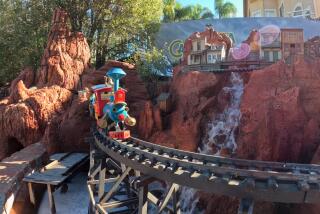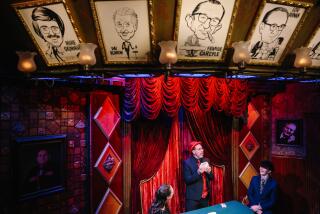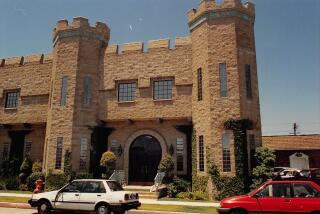Trash was turned into a treasure at Rubelia Castle
Nearly half a century ago, a 20-year-old Southern Californian named Michael Rubel decided for reasons all his own to build a stone castle with a clock tower. So he bought a 2 1/2 -acre citrus orchard in the foothills of his hometown and embarked on a project that would take up nearly the next 30 years of his life.
Rubelia Castle in Glendora was constructed partly out of concrete, but also out of scrap steel, rocks, bedsprings, coat hangers, bottles and whatever other junk Rubel found lying around.
A typical Southern California home it’s not. Depending on who’s looking, it’s kitsch, it’s art, it’s a kid’s-eye view of history, a San Gabriel Valley version of Watts Towers.
Rubel wanted to leave a legacy to the city of his birth.
The result is memorable.
Hidden behind 8-foot walls and giant oaks, its massive electronically operated gate and tunnel-like entrance evoke medieval times -- knights, white horses, damsels in distress. The castle tower, with its circular stairway, looks like the sort of place where Rapunzel might have let down her hair.
“The castle really has no function, no purpose. It’s all a big, wild dream, just as the forts were when I was a kid,” Rubel once said.
Even before its completion in 1986, the castle was becoming a folksy icon in the suburban neighborhood that grew up around it.
Before his death this year, Rubel ensured that status for the future by donating the property to the Glendora Historical Society. The society pays for its upkeep by giving tours and renting out apartments inside the castle and on the grounds.
What gave Rubel the idea for his castle is unclear. But he certainly came from a creative background.
His father, Henry “Heinz” Scott Rubel, was an Episcopal minister and gag writer for radio comedians. During the Roaring Twenties, he married showgirl Dorothy Deuel, whose career included the Ziegfeld Follies and Broadway plays.
In 1936, the couple moved from the East Coast to Glendora, where the elder Rubel was appointed rector of Grace Episcopal Church and worked under contract to Paramount. He drew visitors from all over Southern California to hear both his sermons and his jokes, according to David C. Traversi, author of “One Man’s Dream: The Spirit of the Rubel Castle.” He even made front-page headlines in 1942, when he helped officiate at the wedding of Sally Rand, his wife’s best friend, famous for her racy fan dances.
After Heinz Rubel died in 1946, Dorothy worked full time selling real estate. But Michael, her youngest, then 6, never lacked for guidance. A neighbor who once rode with Pancho Villa became his father figure. Another neighbor, Arthur K. Bourne, was heir to the Singer sewing machine fortune and had a 1,400-acre orange grove. The property served as a playground of sorts for Rubel and a band of friends, who built forts there and swam in the reservoir that provided water for the orange trees.
Bourne’s citrus ranch closed in 1949 but always remained Rubel’s favorite place to play. “I was [Bourne’s] buddy as a kid,” Rubel told the Los Angeles Times in 1974. “I kept telling him that when I grew up I wanted to buy the reservoir and packing house.”
At age 18, Rubel jumped aboard a cruise ship as a cabin boy and spent nearly two years sailing and hitchhiking around the world, working along the way as a cowboy and a ship’s purser.
Meanwhile, Bourne sold all but 2 1/2 acres of his ranch, which he deeded to the Episcopal Church, stipulating that the church had to give Rubel a chance to buy it.
In 1959, hearing the news, Rubel returned home, bought the property with a $200 down payment and settled on his plot, which included citrus orchards, an old packing house and his childhood swimming hole, the reservoir. He moved into the 150-foot-long packing house and turned four of its large cooler compartments into bedrooms. He rented rooms out to his 91-year-old grandfather and his mother, for $40 a month each. They called it the Tin Palace, and his mother filled it full of antiques, including Rand’s rosewood piano.
There, Dorothy Rubel and Rand entertained such greats as Bob Hope and Jack Benny, and held benefits to raise money for the church.
“Grace Episcopal was probably the only church to ever promote a fan dancer,” said Eric Malnic, a former Glendora resident and retired Times reporter.
In the 1960s, Rubel tried unsuccessfully to grow cucumbers and eggplants. Then he tried raising frogs for restaurants, until locals complained of the croaking. In 1968, after he failed at farming, Rubel began driving a school bus.
All the while, he was working on his castle.
In 1969, Rubel said in Times interviews that an old Dutch sea captain left him a “bunch of money,” which helped him pay for his project. “The captain was my salvation . . . but I never thought he liked me,” Rubel said.
While Rubel was building, his grandfather played strip poker with Rand in the castle’s lantern-lit kitchen. Docent Jesse Tomory, who leads tours of the property, likes to tell how Rubel asked Rand why she had lost all her clothes, while his grandfather was still fully dressed. “Don’t you ever win a hand?” Rubel asked. “I do,” replied Rand, “but your grandfather puts on studs, cuff links and a tie and he has to take all those things off first.”
“Rubel was friendly and pleasant, universally liked and relatively private,” Malnic said. “He drove around town in a 1932 Ford Roadster, and once he got started building, he couldn’t stop.”
Without architectural plans, Rubel and a few hundred friends and neighbors salvaged river rock, cement, steel, aluminum, telephone poles and wine bottles to build the six-story castle, with a 74-foot clock tower whose hand-wound clock chimes every hour. Protruding from the castle, wedged in between mortar and rocks, are old motorcycles, tires, sand-filled rubber gloves, a camera, a golf club and a toaster.
Farm hands completed the building after Rubel was disabled by a back injury in the 1980s.
Meanwhile, he was looking for a woman to be his queen.
For eight years, Kaia, a neighbor, refused his marriage proposals.
“She reasoned that our relationship was so perfect that it would be best to leave our lives as is,” Rubel said.
But Rubel refused to give up. While on a trip around the world with her, he persuaded her to marry him. The couple married in Denmark in 1996.
“They walked out of the castle a few years ago, leaving clothes, toothpaste, everything behind, after Rubel had his second heart attack,” Tomory said. “It became too much for them to take care of and they moved into a smaller house a few blocks away.”
Rubel died Oct. 15 at age 67.
Today, a 1940s Santa Fe Red Caboose sits in the middle of the property, which also features antique trucks and tractors, and a cemetery with rejected marble tombstones but no graves.
“It went from an eyesore to being sort of neat. But it took people a while to make the transition,” Malnic said.
--
For tour reservations, call (626) 963-0419. Donations go to the Glendora Historical Society, a nonprofit organization.
More to Read
Sign up for Essential California
The most important California stories and recommendations in your inbox every morning.
You may occasionally receive promotional content from the Los Angeles Times.










